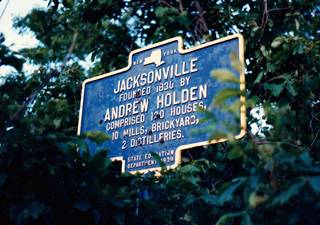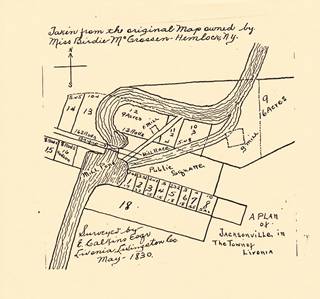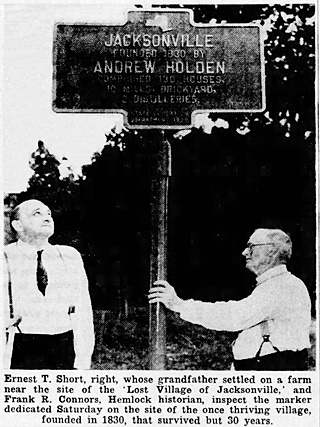
Welcome to Hemlock and Canadice Lakes!
Barns Businesses Cemeteries Churches Clinton & Sullivan Columns Communities Documents Events Time Line Fairs & Festivals Farm & Garden Hiking Homesteads Lake Cottages Lake Scenes Landscapes Library News Articles Old Maps Old Roads & Bridges Organizations People Photo Gallery Podcasts Railroad Reservoir Schools State Forest Veterans Videos
|
History of Jacksonville NY |
|
|
Jacksonville - The Forgotten Village From the publication “Livonia History, 1989”
1 The Landmark sign erect at Jacksonville in 1939. If you were to mention the name of Jacksonville to most residents of the area the name would not be familiar. Few people living in this area know that a thriving and prosperous village called Jacksonville once existed in the Town of Livonia. Jacksonville had its beginning in approximately 1823, when Ichabod Andrew Holden, a prominent resident and distillery owner in Slab City (Hemlock) decided to expand his profitable operations. He built a second distillery one mile north of Hemlock at the foot of Holden’s Hill, on a large tract of land he owned for several years. As this also became profitable, a thriving little settlement began to grow. The first house was built by S. Truman Short, who farmed some 200 acres and raised cattle and sheep. Soon, there was erected a gristmill, a fulling mill, a sawmill, and a dry goods store; all of which Holden created and made so prosperous, that the place called Holdenville at first was later known as Jacksonville. So much business was done there that it was for many years a formidable rival of its neighboring city of Hemlock. It had more than one hundred homes with blacksmith, cooper and shoe shops, and was quite a center of trade, with a good grain market and cloth dress works. Mrs. Marion Russel, Leroy historian, in writing about the slave traffic in this area spoke of the Harvey Blackmer home, Pitts Mansion, and Jacques House at Hemlock Lake as very important stations. Many of the inhabitants of Jacksonville were strong runners and sympathizers of the Negroes. From Jacksonville, the next station was in East Avon some ten miles away. These hearty pioneers accomplished this journey by concealing the slaves in loads of hay and produce and traveling by night. 2 A Map of Jacksonville from 1830. Residents of Jacksonville had high hopes that someday their village would expand enough to join Hemlock, one mile to the south. Indeed at the rate it grew this might have been accomplished within a period of a few short years, but more progress was in the making in the central portion of the Town of Livonia. Most historians feel it was the building of the Erie Railroad through the central portion of the Town of Livonia that started the decline of Jacksonville. As the railroad came no closer than five miles from Jacksonville, merchants soon saw the advantages of being located closer to better transportation. One by one they began closing their mills and shops and moving to Livonia Station. The year was now 1853. The decline of Jacksonville was almost as rapid as its growth. By 1856 it was a “ghost town”. Its founder, Ichabod Holden had passed away. In that year his widow Elizabeth Holden sold all the remaining parcels of land and homes now owned by her. History is very vague as to the details of what happened to the village after this. Apparently most of the homes and business were abandoned and either were torn down or rotted away. In subsequent years the City of Rochester purchased most of the land the village was set upon. Their water line from Hemlock Lake to Rochester runs directly through the old village. Today if you were to drive down the old road that led to Jacksonville, you would be hard pressed to find any evidence of this once thriving community. A New York State Education Department marker now stands approximately in the center of the site by the road, the only clue to the casual visitor, that the empty fields surrounding him once housed the hopes and dreams of our early forefathers. 3 Frank R. Connors, left, Hemlock historian, and Ernest T. Short, inspect the marker dedicated on the site of Jacksonville NY in September 1939. Photo rediscovered by Lore Disalvo. More than a hundred years after Ichabod Holden’s widow sold her property and left Jacksonville, once again the forgotten village came into the limelight. In the summer of 1966, Charles F. Hayes, curator of anthropology at Rochester Museum of Arts and Sciences, with his assistant obtained permission to make a surface survey of Jacksonville. The project was part of the division’s continuing documentation of non-Indian historic sites in western New York in order to satisfy an increasing number of identification requests by both archeologists and the general public. Because of the map that Ichabod Holden had the foresight to have made in 1830 it was possible to survey the former village area with a fair degree of accuracy, despite the fact that the terrain had been altered by construction and farm operations, throughout the last 75 to 100 years. In three days of digging and searching Mr. Hayes and his assistants uncovered many varieties of earthenware, glassware, brick fragments, metal buttons and kaolin pipes. The ceramics were not uncommon in their time, probably readily available items for purchase in an economically growing community. The collection of ceramics from the Jacksonville site will contribute to the understanding of one aspect of daily life in western New York in mid-nineteenth century. It will also aid in identifying and dating the many other sites of this period which remain historically poorly documented. A copy of a Museum Service bulletin of the Rochester Museum carries an article “Ceramics from Jacksonville.” Banded creamware, featheredged creamware, transfer printed ware, spatterware, buff and brown wares and redware were represented in the ceramic fragments from Jacksonville.
|
||


